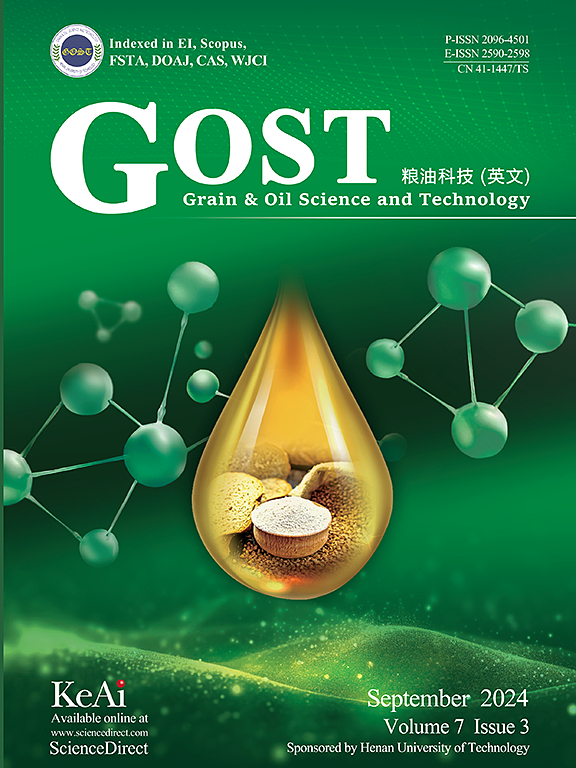山药(薯蓣)粉强化面条体外消化、抗氧化和抗炎作用的探索
Q2 Agricultural and Biological Sciences
引用次数: 0
摘要
研究山药粉对小麦粉面条功能特性的影响,旨在提高面条的营养价值,为山药粉在面制品中的应用提供科学依据。以小麦粉为主要原料,研究了不同YP替代率(0、5%、10%、15%、20%和25%)对制备的面条中多酚含量、2,2-二苯基-1-苦酰肼(DPPH)自由基清除率和淀粉消化率的影响。此外,研究了YP水溶性提取物、小麦面粉和YP浓缩面条(以下简称YP面条)对H2O2 (100 μM)处理后血管平滑肌细胞(VSMCs)炎症因子的影响。结果表明,YP对小麦粉面条的多酚含量和DPPH自由基清除率有显著影响,与对照组相比显著提高(P <;0.05)。在YP取代率为20%的面条中,多酚含量最高达2.17 mg/g,而在YP取代率为25%的面条中,DPPH自由基清除率最高达42.10%。随着YP添加量的增加,面条淀粉水解率和快速消化淀粉含量逐渐降低,抗性淀粉含量显著增加。此外,50、100和200 μg/mL的水溶性YP和YP面条提取物对VSMCs的活力没有显著影响,高浓度的YP和YP面条提取物导致细胞死亡。YP和面条提取物均可降低h2o2处理的VSMCs中炎症因子IL-6和TNF-α的分泌水平。总的来说,添加YP降低了淀粉消化率,提高了抗氧化活性,有效改善了面条的功能品质。本研究为有益健康的抗炎食品的研究和开发提供了参考。本文章由计算机程序翻译,如有差异,请以英文原文为准。

Exploration of in vitro digestive, antioxidative, and anti-inflammatory benefits of yam (Dioscorea rhizoma) powder-enriched noodles
The effects of yam powder (YP) on the functional properties of wheat flour noodles were investigated to improve the nutritional value of noodles and provide a scientific basis for YP application in flour products. Using wheat flour as the main ingredient, the effects of different YP substitution ratios (0, 5 %, 10 %, 15 %, 20 %, and 25 %) on polyphenolic content, 2,2-diphenyl-1-picrylhydrazyl (DPPH) free radical scavenging rate, and starch digestibility of the prepared noodles were analyzed in vitro. Additionally, the effects of YP water-soluble extracts, wheat flour noodles, and YP-enriched noodles (hereinafter, YP noodles) on inflammatory factors in vascular smooth muscle cells (VSMCs) treated by H2O2 (100 μM) were investigated. The results showed that YP had a substantial effect on polyphenolic content and DPPH free radical scavenging rate of wheat flour noodles, significantly increasing both values compared with those of the control group (P < 0.05). The polyphenolic content reached a maximum of 2.17 mg/g in noodles with 20 % YP substitution, whereas DPPH free radical scavenging rate reached a maximum of 42.10 % in noodles with 25 % YP substitution. With an increase in YP amount, both starch hydrolysis rate and rapidly digestible starch content of the noodles decreased gradually, whereas resistant starch content increased significantly. Moreover, 50, 100, and 200 μg/mL of water-soluble YP and YP noodle extracts had no significant effect on the viability of VSMCs, and high concentrations of YP and YP noodle extracts resulted in cell death. Both YP and noodle extracts also reduced the secretion levels of inflammatory factors IL-6 and TNF-α in H2O2-treated VSMCs. Overall, YP addition reduced starch digestibility, increased antioxidative activity, and effectively improved functional quality of noodles. This study provides reference for the research and development of health-benefiting anti-inflammatory foods.
求助全文
通过发布文献求助,成功后即可免费获取论文全文。
去求助
来源期刊

Grain Oil Science and Technology
Food Science
CiteScore
7.30
自引率
0.00%
发文量
69
审稿时长
12 weeks
期刊介绍:
 求助内容:
求助内容: 应助结果提醒方式:
应助结果提醒方式:


